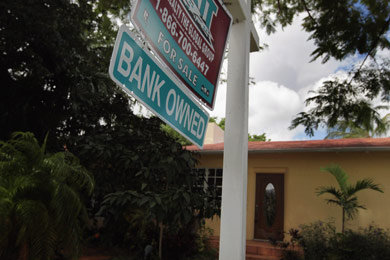The number of homeowners dropped from the government's mortgage modification program continued to mount last month, according to new numbers released yesterday. The results also demonstrate the increasingly limited reach of the program.
Take a look at our graphical rundown of the numbers, broken down by each bank or mortgage servicer participating in the program.
The administration has never clearly stated exactly how many modifications it aimed to enable through the program. Its only goal has been for mortgage servicers to make three to four million trial modification offers to homeowners by the end of 2012, a target the TARP's inspector general derided as "essentially meaningless" because only a portion of those offers result in permanent modifications.
But the Treasury Department, which runs the program, is unlikely to meet even that modest goal, as things start to slow. If the pace of trial offers made in the last three months continues (approximately 25,000 each month), the program would fall short of three million offers by several hundred thousand.
Meanwhile, less than half of the trials granted have resulted in a permanent modification. So far, about 1.3 million homeowners have begun a trial, a temporary reduction in payments that's supposed to last three or four months. For most, it has lasted longer than that.
About 1.1 million have received a final answer from their servicer. For nearly 60 percent of them, the answer was that they did not qualify for the program. Only 468,000 homeowners have received a modification through the program.
Below is a chart showing the most common reasons that homeowners have been disqualified from the program by their servicer, according to data the Treasury Department turned over to the Congressional Oversight Panel last month. It's based on the servicers' reports to Treasury.

The data raise "important questions" about why so many homeowners have been disqualified, the congressional panel writes. The most common reason was "request incomplete," which means the servicer reported that the homeowner did not submit all the necessary documents.
As we've reported here numerous times, the servicers often lose documents homeowners send in. Of the 373 homeowners who responded to a questionnaire we did, 232 said the servicer had lost their documents. Nearly as many, 214, said the servicer had accused them of failing to supply documents for which they'd never asked.
The panel also noted that in about 12 percent of cases, the servicer didn't even offer a reason for a denial when reporting it to the Treasury. (See the line "Denial Code Missing" in the graphic above.)
Treasury officials have repeatedly stressed that many homeowners who've been disqualified for modifications through the program have ultimately received other modifications from their servicer. That's been the case for about 45 percent of the cancelled modifications, according to Treasury. While such modifications typically do cut the homeowner's monthly payments, they tend to be less generous, resulting in a greater likelihood of re-default.












